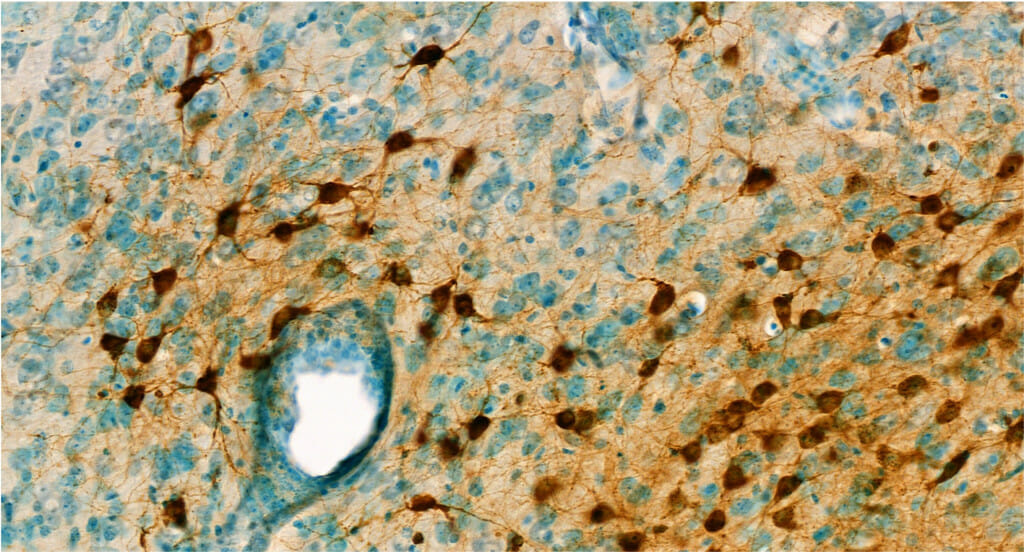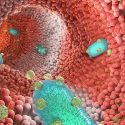Brain-penetrating drug candidate effective against deadly encephalitis viruses

This image shows a mouse brain cells infected with Venezuelan equine encephalitis virus, which is one of two viruses that cause encephalitis that are neutralized by a compound discovered by UW–Madison researchers. Image courtesy of Dr. Yi Xue
A new antiviral compound designed and synthesized by researchers at the University of Wisconsin–Madison’s School of Pharmacy is highly effective in mice against two types of devastating encephalitis viruses that are harmful to humans.
UW–Madison researchers developed the compound, a quinazolinone known as BDGR-49, in collaboration with cellular virologists at the University of Louisville and researchers at the University of Tennessee Health Science Center who performed animal efficacy studies. The multidisciplinary team found that BDGR-49 protects mice infected with deadly eastern equine encephalitis virus (EEEV) or Venezuelan equine encephalitis virus (VEEV).
The researchers described BDGR-49 and its efficacy against lethal infections of EEEV or VEEV in mouse models in a study published April 12 in Science Translational Medicine.

Jennifer Golden
“Collaboration across disciplines and capabilities was key to this discovery,” says Jennifer E. Golden, a UW–Madison professor of pharmacy and chemistry and synthetic medicinal chemist who led the discovery and optimization effort. Colleen Jonsson, professor at UTHSC, tested the compound in mice. Donghoon Chung, a professor of microbiology and immunology at Louisville’s Center for Predictive Medicine, performed further virology studies.
The team found that BDGR-49 potently inhibited EEEV and VEEV and was well tolerated in mice. The compound provided significant protection to EEEV-infected animals. Meanwhile, it not only fully protected VEEV-infected mice, but could also be used as a therapeutic treatment days after infection.
“We had been working on a different compound structure for years,” says Golden. “Compounds that emerged from that earlier work were pivotal to understanding how to construct a better antiviral compound class that works well against VEEV and EEEV — ultimately providing a roadmap to the design and discovery of BDGR-49.”
An important feature of this antiviral compound is its ability to access the brain where these viruses cause damage, while other critical attributes include its improved stability, potency and efficacy compared to earlier prototypes Golden and her collaborators developed. Based on resistance studies, BDGR-49 efficiently prevents these viruses from copying themselves, implicating that it operates by disrupting the viral machinery needed for replication.
Classified as New World alphaviruses, equine encephalitis viruses are transmitted by the bite of a mosquito and can infect the brain, causing neurological effects, serious illness and death in humans as well as horses. There currently are no FDA-approved vaccines or treatments available specifically for preventing or treating alphavirus infection in humans.
Symptoms of EEEV infection include fever, headache, chills and vomiting. Severe infection can result in seizure, coma and death. About one-third of individuals who develop encephalitis (brain inflammation) from EEEV infection die, and many of those who do recover suffer permanent neurological effects.
Although outbreaks of eastern equine encephalitis are rare, with an average of 11 cases per year in the United States, in 2019 an outbreak across nine states resulted in 38 confirmed cases, 19 deaths and neurological effects in survivors.
Venezuelan equine encephalitis has a much lower mortality rate of 1%, but outbreaks can affect thousands of people, most often occurring in Central and South America. While insect bites are the typical source of these infections, there is also concern the viruses could be used as bioweapons.
The team has been developing and optimizing chemical structures against VEEV and EEEV for more than a decade. Golden, Jonsson and Chung are co-investigators in the Center of Excellence for Encephalitic Alphavirus Therapeutics, based at UTHSC. The center was created to refine the properties and activity of early-stage small molecule compounds discovered in the Golden lab and to develop them into clinical candidates for VEEV and EEEV that could be studied in humans.
“There are no approved prophylactic or therapeutic options in our arsenal for any human alphavirus infection, so our goal is to develop a drug against VEEV and EEEV that is safe and effective in humans,” Golden says. “While there is still much work to be done, the discovery of BDGR-49 is a remarkable achievement in reaching that goal based on the compound’s drug-like characteristics and ability to prevent animals from dying from these infections.”
The team is evaluating BDGR-49 in advanced preclinical studies while expanding the understanding of its antiviral properties. As RNA viruses such as EEEV and VEEV are prone to develop mutations, they can potentially evolve into more lethal or transmissible versions without warning, resulting in widespread infections.
“It is essential that we develop these countermeasures for viruses of pandemic potential so we don’t find ourselves unprepared to respond to an outbreak,” Golden says. “We can do better, and we intend to leverage this discovery as broadly as possible with respect to VEEV, EEEV and other viruses of concern.”
This research was supported by the National Institute of Allergy and Infectious Diseases (U19AI142762 and R01AI118814) and by a grant (S10OD016226) from the Office of the Director of the NIH.



